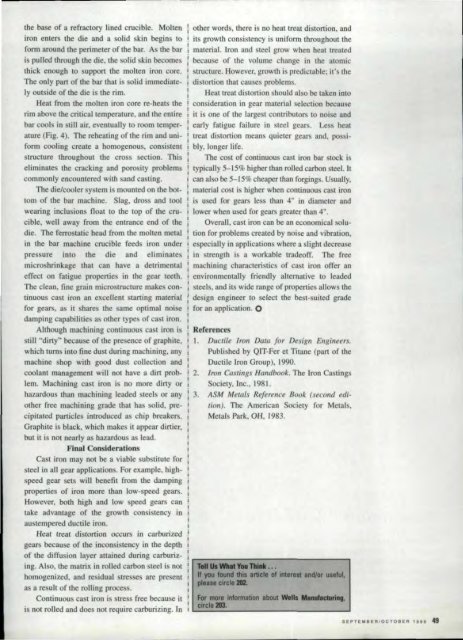Download the September/October 1999 Issue in PDF format - Gear ...
Download the September/October 1999 Issue in PDF format - Gear ...
Download the September/October 1999 Issue in PDF format - Gear ...
You also want an ePaper? Increase the reach of your titles
YUMPU automatically turns print PDFs into web optimized ePapers that Google loves.
tile ba e of a refractory l<strong>in</strong>ed crucible. Molten<br />
iron enters tile die and a solid sk<strong>in</strong> beg<strong>in</strong>s to<br />
form around <strong>the</strong> perimeter of <strong>the</strong> bar. As <strong>the</strong> bar<br />
is pulled through <strong>the</strong> die, <strong>the</strong> oIid sk<strong>in</strong> becomes<br />
thick enough to support <strong>the</strong> molten iron core.<br />
The only part of <strong>the</strong> bar that is solid immediately<br />
out ide of <strong>the</strong> die is <strong>the</strong> rim,<br />
Heat from <strong>the</strong> molten<br />
iron core re-heats <strong>the</strong><br />
lim above <strong>the</strong> critical temperature. and <strong>the</strong> eruire<br />
bar cools <strong>in</strong> till air, eventually to roorntemperature<br />
(Fig. 4). The reheat<strong>in</strong>g of <strong>the</strong> rim ami uniform<br />
cool<strong>in</strong>g create a homogenou • con i tent<br />
structure throughout nle ems ection, Thi<br />
elim<strong>in</strong>ate <strong>the</strong> cra.ck<strong>in</strong>g andporosiry problems<br />
commonly encountered with sand ca ung,<br />
The die/cooler<br />
y tern i mounted on <strong>the</strong> bottom<br />
of <strong>the</strong> bar mach<strong>in</strong>e, Slag. dro and tool<br />
wear<strong>in</strong>g <strong>in</strong>clusions float to <strong>the</strong> top of <strong>the</strong> crucible,<br />
well away from <strong>the</strong> entrance end of <strong>the</strong><br />
die, The ferro tane head from <strong>the</strong> molten metal<br />
<strong>in</strong> <strong>the</strong> bar mach<strong>in</strong>e crucible feed iron under<br />
pre ure <strong>in</strong>to <strong>the</strong> die and elim<strong>in</strong>ates<br />
microshr<strong>in</strong>kage [hat can have a detrimental<br />
effect on fatigue properties <strong>in</strong> Ihe gear teeth,<br />
The clean, f<strong>in</strong>e gra<strong>in</strong> microstructure makes cont<strong>in</strong>uous<br />
cast iron an excellent lart<strong>in</strong>g material<br />
for gears, II it share <strong>the</strong> arne optimal noise<br />
damp<strong>in</strong>g capabilities as o<strong>the</strong>r types of castiron.<br />
Although mach<strong>in</strong><strong>in</strong>g cont<strong>in</strong>uous cast iron i<br />
still "dirty" becau e of <strong>the</strong> pre ence of graphite.<br />
which turns <strong>in</strong>to f<strong>in</strong>e dust dur<strong>in</strong>g mach<strong>in</strong><strong>in</strong>g, a~y<br />
mach<strong>in</strong>e shop with good dust collection and<br />
coolant management will not have a d<strong>in</strong> problem.<br />
Mach<strong>in</strong><strong>in</strong>g cast iron is 11\0 more dirty or<br />
hazardous than mach<strong>in</strong><strong>in</strong>g leaded steels or any<br />
o<strong>the</strong>r free mach<strong>in</strong><strong>in</strong>g grade (hal has sclid, precipita~ed<br />
pani les <strong>in</strong>troduced as chip breaker .<br />
Graphite is black, which :makes it appear dirtier,<br />
but it ;i . not nea.r.lyas hazardous as lead.<br />
F<strong>in</strong>aEConsiduatioDS<br />
Cast iron may not be a viable substitute ~or<br />
steel <strong>in</strong> all gear applications. For example, highspeed<br />
gear ets will benefit from <strong>the</strong> damp<strong>in</strong>g<br />
properties of iron more than [ow-speed gears.<br />
However, both high and low speed gears can<br />
take advantage of <strong>the</strong> growth consistency <strong>in</strong><br />
au tempered ductile Iron,<br />
Heal: treat distortion occurs if! cerburized<br />
gears. becau e of <strong>the</strong> <strong>in</strong>consistency <strong>in</strong> <strong>the</strong> depth<br />
of <strong>the</strong> diffusion layer atta<strong>in</strong>ed dur<strong>in</strong>g carburiz<strong>in</strong>g.<br />
Also, <strong>the</strong> matrix <strong>in</strong> rolled carbon steel is nCI<br />
homogenized. and residual Ire e. are present<br />
as are lilt of <strong>the</strong> roll<strong>in</strong>g process.<br />
Cont<strong>in</strong>uous cast. iron is stress freebecause il<br />
is not rolled and does not require carburiz<strong>in</strong>g. In<br />
o<strong>the</strong>r words. <strong>the</strong>re i DO heat treat distortion. and<br />
its growth consistency is uniform throughout <strong>the</strong><br />
material. mron and steel grow when heat treated<br />
because of <strong>the</strong> volume change <strong>in</strong> <strong>the</strong> atomic<br />
structure. However. growth is predictable; it' <strong>the</strong><br />
distortion that causes problem.<br />
Heal treat di tortion should also be taken <strong>in</strong>to<br />
consideration <strong>in</strong> gear material selection because<br />
it i one of <strong>the</strong> large t contributors 10 noise and<br />
early fatigue failure <strong>in</strong> reel gears. Less heal.<br />
treat di tortion means quieter gears and, posslbly,<br />
longer life.<br />
The cost of cont<strong>in</strong>uous cas! iron bar rock is<br />
typically 5-]5% higher than rolled carbon steel. h<br />
can al a be 5-]5% cheaper than forg<strong>in</strong>gs. Usua1ly,<br />
material cost is higher when eent<strong>in</strong>uou<br />
cast iron<br />
is u ed for gears less than 4" <strong>in</strong> diameter and<br />
lower when u ed for gears greater than 4".<br />
Overall, cast iron can be an economical solution<br />
for problem created by noise and vibration,<br />
especially <strong>in</strong> applications where 3. slight decrease<br />
<strong>in</strong> !:rengl:h is a workable tradeoff. The free<br />
mach<strong>in</strong><strong>in</strong>g characteristics. of ca I iron offer an<br />
environmentally friendly alternative to leaded<br />
steels, and its,wide range of properties allows <strong>the</strong><br />
design eng<strong>in</strong>eer to select <strong>the</strong> be t-suited grade<br />
for an application. 0<br />
References<br />
L Ductile Iron Data for Design Eng<strong>in</strong>eers.<br />
Published by Q]T-Fer et Titane (pan of <strong>the</strong><br />
Ductile leon Group), 1990.<br />
2. Iron Cast<strong>in</strong>gs Handbook. The Iron Cast<strong>in</strong>gs<br />
Society, Inc .• 1981.<br />
3. ASM Metals Reference Book (second edition).<br />
The American Society for Metals.<br />
Metal Park. OR. 1983.<br />
Tell Us WhM You Th<strong>in</strong>k ...<br />
If you found this article of Interest and/or useful,<br />
please circle 2IIZ.<br />
For more <strong>in</strong><strong>format</strong>ion about W.II, Manuf1lctur<strong>in</strong>g,<br />
circle 203.<br />
SEPTEIMBEAIOCTOBER<br />
lUI.
















